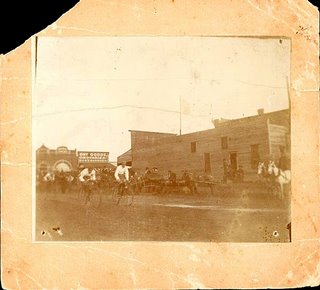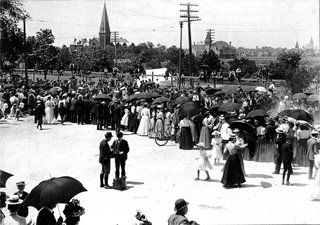How the bicycle put Detroit on wheels
By Vivian M. Baulch / The Detroit News
It was no accident of history, no mysterious collision of cosmic forces, that caused the auto industry to take root in the city of Detroit. It was bound to happen here sooner or later.
The reasons? The bicycle, for one.
In the late nineteenth century, the young city of Detroit was already obsessed with wheels. It was home to a myriad of small shops making carriages and bicycles. These shops were filled with tinkerers for whom the simple idea of adding a motor to a wheeled contraption seemed obvious.
Early precursors to the bicycle had emerged in Europe in the first half of the last century, and by the 1890's bicycling was the craze in Detroit.
Faded clippings from the newspapers of the day suggest that the use of bicycles was almost universal, with 80 percent of the city's population racing around town on them. Outnumbered pedestrians feared crossing the roads.
During the bicycling craze of the 1890s, men debated the propriety of bloomers as feminine cycling attire, like this bloomer girl on the road. Many came forward to denounce the styles of the day.
Bicycling enthusiasts formed small clubs that eventually merged into the powerful Wheelmen Club, formed by Armand H. Griffin, director of the Art Museum. In the early days the club met informally in C.F. Smith's photo gallery on Woodward, then in rented quarters at Clifford and Elizabeth, and later on Miami Avenue (now Broadway). The rapidly growing Wheelmen moved to Randolph street in 1893 and soon after the club's 350 members decided they needed new larger quarters on Adams.
This fast crowd of cyclists were the first Detroiters to complain about bumpy potholed dirt roads and began lobbying for smooth paving. Historians attribute the automobile's explosion of growth in Detroit to the network of superior roads built for bicyclists. So popular had biking become that ministers feared church attendance would decline. One preacher quoted Shakespeare:
"Out, out, thou strumpet Fortune!
Break all the spokes and fellies from her wheel,
And bowl the round nave down the hill of heaven
As low as to the fiends!"
More tolerant preachers installed bicycle racks outside their churches.
Bicycle enthusiast Harry Shaw of Saginaw rides his new bike in 1880.
The early wheelmen not given to worship breezed past the churches, racks or no, for the nearest saloon.
There they chatted about "the proper gear of a bike, the cushioned saddles, and whether handlebars should have wooden, cork or leather grips, and whether the bars should be over- or underslung, and the advantages of chainless models over those chaindriven, which required clamps on the trousers, and what buildings and shops provided parking for bicycles, and the best routes for country driving, and whether Barney Oldfield could beat Earl Kiser or Ollie Schrein in a bicycle race at the fairgrounds."
In 1894 more than 250,000 bicycles were manufactured in the United States; 400,000 in 1895. In 1899, 312 bicycle factories, with capital worth $30 million and a production of 1.1 million machines, worked to satisfy enthusiasts. The bikes cost $100 plain and $125 fancy, a not inconsiderable sum of money at the time. But within 10 years the bicycling fade began to fade, replaced by newfangled motorized contraptions.
A visitor to an early motorized bicycle exhibit wrote, "On the day of my visit the motor bicycle was not working, as usual, in the basement owing to some accident. Some of the habitues of the show who had seen the thing run told me that it seemed to work well enough, but made a good deal of hissing noise. Admitting that it will do all that its manufacturers say, the present cost will prove an obstacle to its wide introduction, the cheapest form being sold at $275 and another --a four-wheeled affair-- at $500."
Many of the most famous names associated with the early days of the auto industry actually got their starts in bicycling.
New trolley John Dodge
John and Horace Dodge produced bicycles until 1901 when they opened a machine shop in Detroit to make stove parts, and later auto parts. In 1910 they established The Dodge Brothers plant in Hamtramck, where they made engines and other parts for Ford and Olds. In 1913 they began making cars and by their deaths in 1920 their company was one of the largest in the industry.
When Henry Ford teamed with bike racer Tom Cooper to build a racing automobile in 1902, neither had the nerve to drive it. The car, called "999," was so fast they called on fearless bicycling daredevil and speed demon Barney Oldfield to drive it for them.
Horace Dodge
In those early days, one of the fastest and most daredevil racing bicyclists, Barney Oldfield, captured the imagination of slower riders.
Barney, at age 24 a professional bicycle rider, had a reputation as one of the fastest and most daring racing bicyclists in the counrty, and had also sped fearlessly on the new motorcycles.
In a short autobiography written for The Detroit News shortly before his death in 1946, Oldfield told how Cooper wrote to him in Salt Lake City, where he was racing at the Salt Palace.
"I drew out my savings from the Wells Fargo Bank, $650 in gold, and went to Detroit, riding the cushions to save Pullman fare. Tom Cooper met me at the depot, escorted me to Ford's shop on Bagley, and introduced me to Henry Ford."
They showed him the 999.
"But I've never driven a car." Barney said.
"It's easy," Ford said. "We'll teach you."
On that morning of the race, Ford taught him the controls.
Years later Ford himself recalled the Oldfield race: "He never looked around. He never shut off on the curves; he simply let the car go. He was about half a mile ahead of the second car at the end of the race."
Speed demon Barney Oldfield at the wheel of an early race car.
The Detroit News-Tribune of Oct. 26, 1902 reported:
"Hatless, his long tawny hair flying out behind him with the speed of his mount, Barney Oldfield, the old bicycle star, gave the crowd at the automobile races yesterday one of the greatest exhibitions of reckless daredevil driving that has been seen on the circuit this year.
"The ex-bike rider was in his glory. He had the speed of the party in the big Challenge Cup race, but he meant to make his win as impressive as possible.
"With never a slowdown he charged the turns, slewing frequently the entire width of his machine and seeming a dozen times on the verge of a capsize.
"The machine never faltered, however. It tore down the straights like a fiend incarnate, spitting fire with explosions that could be heard clear across the track, increasing to deafening force when the machine passed the grandstand."
The five-mile race, run on a one-mile circular track in Grosse Pointe, starred the world champion, Alexander Winton of Cleveland, who drove a car he had built himself, Winton's bullet. Until that morning, the Bullet was regarded as the fastest thing on wheels. He dropped out in the last lap with engine trouble, a half mile behind Oldfield, who had lapped the 'Pup' (second place) and the 'Steamboat.'
Later Oldfield broke the record 1.2 minute mile on West Grand Boulevard, in 52.8 seconds. Many a traffic cop subsequently stopped speeders with the line, "Who do you think you are, Barney Oldfield?"
In Oldfield's obituary, Ford remembered what Oldfield had said before the classic 1902 race: "Well, this chariot may kill me, but they'll say afterward I was going like hell when she took me over the bank."


